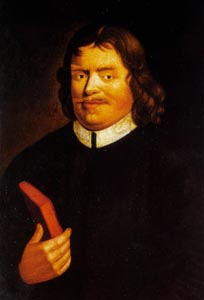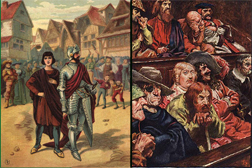John Bunyan
From the Quicksilver Metaweb.
a page for Everyman
Stephensonia
Enoch Root is the closest Stephenson character to Everyman in the Baroque Cycle universe as katana experts or math savants are rare on the ground as it were ...
Authored entries
John Bunyan
From Wikipedia, the free encyclopedia.
John Bunyan (November 30, 1628 -August 31, 1688), a Christian writer and preacher, was born at Harrowden (1 mile south-east of Bedford), in the Parish of Elstow, England. He wrote The Pilgrim's Progress, arguably the most famous published Christian allegory.

JOHN BUNYAN
Life
Bunyan had very little schooling, followed his father in the tinker's trade, served in the parliamentary army (1644 - 1647); married in 1649; lived in Elstow till 1655 (when his wife died) and then moved to Bedford. He married again in 1659. He was received into the Baptist church in Bedford by immersion in the Ouse in 1653.
In 1655 he became a deacon and began preaching, with marked success from the start. In 1658 he was indicted for preaching without a license; kept on, however, and did not suffer imprisonment till November 1660, when he was taken to the county jail in Silver Street, Bedford, and there confined (with the exception of a few weeks in 1666) till January 1672.
In that month he became pastor of the Bedford church. In March 1675 (the original warrant, discovered in 1887, is published in facsimile by Rush and Warwick, London), he was again imprisoned for preaching, this time in the Bedford town jail on the stone bridge over the Ouse. In six months he was free and was not again molested.
On his way to London he caught a severe cold from being wet, and died at the house of a friend at Snow Hill on August 31, 1688. His grave lies in the cemetery at Bunhill Fields in London.
The Pilgrim's Progress
The Pilgrim's Progress from This World to That Which Is to Come is an allegory by John Bunyan. Bunyan wrote this book while imprisoned in 1675 for violations of the Conventicle Act which punished people for conducting unauthorised religious services outside of the Church of England.
The allegory tells of Christian, an Everyman character who must make his way from the City of Destruction to the Celestial City of Zion. During his travel, he must make his way past hazards such as the Slough of Despond, temptations like Vanity Fair, and foes like the Giant Despair. Due to the long popularity of this devotional book, many of these phrases have become proverbial in English.
-
An allegory (from language Greek αλλος, allos, "other", and αγορευειν, agoreuein, "to speak in public") is a figurative representation conveying a meaning other than and in addition to the literal. It is generally treated as a figure of rhetoric, but an allegory does not have to be expressed in language : it may be addressed to the eye, and is often found in painting, sculpture or some form of mimetic art. The etymological meaning of the word is wider than that which it bears in actual use. An allegory is distinguished from a metaphor by being longer sustained and more fully carried out in its details, and from an analogy by the fact that the one appeals to the imagination and the other to the reason. The fable or parable is a short allegory with one definite moral. The allegory has been a favourite form in the literature of nearly every nation. The Hebrew scriptures present frequent instances of it, one of the most beautiful being the comparison of the history of Israel to the growth of a vine in the 80th Psalm. In classical literature one of the best known allegories is the story of the stomach and its members in the speech of Menenius Agrippa ( Livy ii. 32); and several occur in Ovid 's Metamorphoses. Some elaborate and successful specimens of allegory are to be found in the works of authors:
-
Edmund Spenser's The Faerie Queene
- Jonathan Swift's A Tale of a Tub
- Addison's Vision of Mirza,
-
Aesop 's Fables
-
A proverb (from the Latin Proverbium ) is some truth that is in a way important for a community and is passed on from generation to generation. By observation, experimentation, and knowledge sharing a proverb is formed. It must endure the test of time. It must be short and catchy and it must be true. (Nonetheless, proverbs are often contradictory.) By repetition it becomes immortal.
-
Everyman (c. 1509-19) is a morality play. It derives from a Flemish original and is 921 lines long. Everyman, a representative figure of the human race, is summoned by death. He discovers that his friends Fellowship, Kindred, Cousin, and Goods will not go with him. It is Good Deeds, whom he previously neglected, who finally supports him and who offers to justify him before the throne of God. In literature and drama, the term "everyman" has come to mean an ordinary individual, with whom the audience or reader is supposed to be able to identify, who is often placed in extraordinary circumstances.
Bunyan wrote The Pilgrim's Progress in two parts, of which the first appeared at London in 1678, and was at all events, begun during his imprisonment in 1676; the second in 1684. The earliest edition in which the two parts combined in one volume came in 1728. A third part falsely attributed to Bunyan appeared in 1693, and was reprinted as late as 1852.
The Pilgrim's Progress is the most successful allegory ever written, and like the Bible has been extensively translated into other languages. Protestant missionaries commonly translated it as the first thing after the Bible.
Two other works of Bunyan's would have given him fame, but not as wide as that he now enjoys; viz., The Life and Death of Mr. Badman (1680), an imaginary biography, and the allegory The Holy War (1682).
The book which lays bare Bunyan's inner life and reveals his preparation for his appointed work is Grace Abounding to the chief of sinners (1666). It is very prolix, and being all about himself, in a man less holy would be intolerably egotistic, but as Bunyan plainly had the motive in writing it to exalt the grace of God and to comfort those passing through experiences somewhat like his own, his egotism makes no disagreeable impression.
The works just named have appeared in numerous editions, and are accessible to all. There are several noteworthy collections of editions of The Pilgrim's Progress, e.g., in the British Museum and in the New York Public Library, collected by the late James Lenox.

Two Scenes from Vanity Fair
Bunyan became a popular preacher as well as a very voluminous author, though most of his works consist of expanded sermons. In theology he was a Puritan, but not a partisan; nor was there anything gloomy about him.
The portrait which his friend Robert White drew, which has been often reproduced, is a most attractive one and this was his true character. He was tall, had reddish hair, prominent nose, a rather large mouth, and sparkling eyes.
He was no scholar, except of the English Bible, but that he knew thoroughly. He also drew much influence from Martin Luther's Commentary on the Epistle to the Galatians, in the translation of 1575.
Some time before his final release from prison Bunyan became involved in a controversy with Kiffin, Danvers, Deune, Paul, and others. In 1673 he published his Differences in Judgement about Water-Baptism no Bar to Communion, in which he took the ground that "the Church of Christ hath not warrant to keep out of the communion the Christian that is discovered to be a visible saint of the word, the Christian that walketh according to his own light with God." While he owned "water baptism to be God's ordinance," he refused to make "an idol of it," as he thought those did who made the lack of it a ground for disfellowshiping those recognized as genuine Christians.
Kiffin and Paul published a rejoinder in Serious Reflections (London, 1673), in which they ably set forth the argument in favor of the restriction of the Lord's Supper to baptized believers, and received the approval of Henry Danvers in his Treatise of Baptism (London, 1673 or 1674). The controversy resulted in the Particular (Calvinistic) Baptists leaving the question of communion with the unbaptized open. Bunyan's church admitted pedobaptists to fellowship and finally became pedobaptist (Congregationalist).
Related entries
External links
- Project Gutenberg e-texts of some of John Bunyan's works
- James Clarke & Co Ltd, 1987, ISBN 0718821645
- Penguin Books, London, 1987, ISBN 0140430040